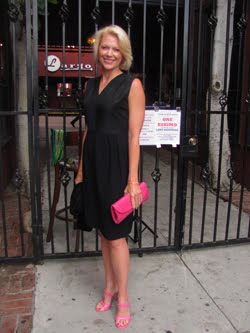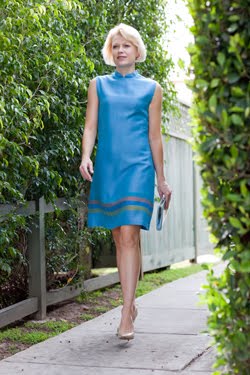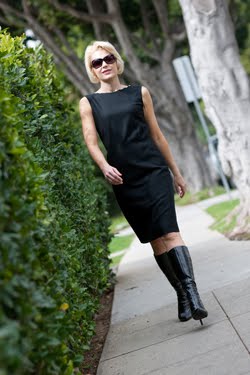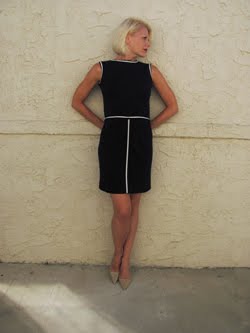I originally wrote the piece below several years ago, but wanted to update it and share again for any who attended my event along with those who were not able to join us. Last year was the 40th anniversary of Annie Hall and menswear is still one of the strongest trends in fashion, so it's a perfect time to celebrate its ongoing legacy.
-----
Woody Allen films have always been a favorite of mine. Growing up as I did in Central Washington was wonderful if you were into the great outdoors, but the area was not exactly known as a cultural Mecca. Woody's movies became an intellectual oasis for me - a place I could count on for that perfect combination of insightful writing and elegant style. I was blown away by the sophistication of New York and how much Woody filled that world with literary, musical, and cultural references. Many artists, such as Diane Arbus and August Strindberg, were first introduced to me through Woody's dialogue and his soundtracks gave me an early education on jazz. I also became a huge fan of cinematographers because of the extraordinary lighting in his films (sometimes in black and white) and was introduced to many of my all-time favorites, such as Sven Nykvist, Carlo di Palma, and especially "The Prince of Darkness" himself Gordon Willis.
With Willis by his side, Woody transitioned from his "early funny films" - such as Bananas and Sleeper - into the dramatic comedy of Annie Hall. This was a "major turning point" in his career. Though he had been a success in comedy since his late teens, there had always been much more to Woody than just jokes. He pondered philosophy, theology, and existentialism even as a child. The earliest incarnation of Annie Hall was called Anhedonia - meaning "the inability to experience pleasure" - and had even more of an introspective mood. A series of comic sketches explored many of the themes that Woody would become known for, but they didn't connect together as well as Woody hoped and the film lacked an engaging narrative.
In this first incarnation, the character of Annie was only briefly included, almost in the background. As Woody, co-writer Marshall Brickman, and editor Ralph Rosenblum went over it (and over it and over it), they saw that the energy came from the relationship between Alvy Singer and Annie. Though all the writing, acting, and directing had been great, the story we now know really emerged during this editing process. Scenes were rewritten and reshot - multiple times over a 10 month period. The character of Annie was brought to the fore and the movie looked at a couple falling in (and out) of love. It's no wonder entire books have been written on all that took place to make the movie that is now the gold standard for romantic comedies.
One of the reasons for its perfection is unquestionably the presence of Diane Keaton. It was her style with the backdrop of an idealized intellectual New York City that mesmerized me. Woody loves to deny the autobiographical nature of Annie Hall, but there are many details that happen to be true. At the top of a long list is the fact that Diane's real name is Annie Hall ("Annie" was her nickname). And her family may be from Orange County, California instead of Chippewa Falls, but they are still similar to their depiction at the dinner table in the movie right down to Grammy Hall. The overall character of Annie is also so close to Keaton's own - the naturally bubbly and slightly goofy beauty who exhibits such an otherworldly sense of style that mere mortals can only call it genius.
Make no mistake though the character may be Annie Hall, the style is pure Diane Keaton. The clothes that became costumes for the movie mostly came straight from her own closet. The style is so authentically her own that she continues to dress this way to this day. But interestingly, the movie's costume designer Ruth Morley often gets credit for the groundbreaking style, including by other well respected designers and scholars like Deborah Nadoolman Landis in her book Dressed. But I must tell you, I have a really hard time believing it, especially when she reportedly disapproved so strongly of Diane's clothing choices. In fact, Woody remembered a conversation with the costume designer during a 1995 interview:
[Morley] said, '"Tell her not to wear that. She can't wear that. It's so crazy."
And I said, "Leave her. She's a genius. Let's just leave her alone, let her wear what she wants.'"
When Annie Hall hit the movie theaters in 1977, it was a seismic shift in fashion as well as film. It was a revolution from the runways to the street, particularly when it came to menswear. Diane's reference points were inspired - everything from the menswear of the 1920s and 1940s to the bohemian feel of the 1960s and 1970s. She also admitted to being inspired by "the cool-looking women on the streets of SoHo. Annie's khaki pants, vest, and tie came from them." Her hat from that iconic ensemble came from the wife of the production designer of The Godfather films. Diane could simultaneously draw from the past and present while also being ahead of the trend. She redefined menswear for the 1970s and beyond.
In addition, with every look Diane taught us her love of layering. Her outfits are built with accessories like hats, scarves, and gloves (though gloves do not appear in Annie Hall) and she regularly wears every single one with an outfit. I believe it was Coco Chanel's edict to remove one item of an outfit before heading out the door, but Diane has the opposite idea. She shows us how to effectively layer a look, and many of the ones from Annie Hall continue to be popular today. Countless designers (Jenna Lyons at J. Crew), stylists (Rachel Zoe), models (Kate Moss), and celebrities (Rachel Bilson) have drawn inspiration from her style. What's incredible is that it does not matter what your personal style happens to be, everyone seems to be influenced in some way by Annie Hall. Diane may have won the Best Actress Oscar for the film, but she also definitely deserves a lifetime achievement award for her iconic style.
Seems like old times indeed.
We meet Alvy Singer in a red plaid shirt (over a brown t-shirt) with a brown checked blazer,
who leads us into his latest disagreement with his girlfriend Annie Hall
who leads us into his latest disagreement with his girlfriend Annie Hall
Now we are introduced to Annie Hall and her style--
wearing a sundress over a black turtleneck and pairs it with a scarf
We learn that Alvy first met Annie playing tennis and liked her right away
The iconic outfit of Annie Hall - menswear with a modern touch -
white buttondown, tie, black vest, and khakis
accessorized with a black hat and her favorite woven bag
accessorized with a black hat and her favorite woven bag
Alvy compliments Annie on her style -
his own fantastic all white look is the result of Ruth Morley (and likely Ralph Lauren)
his own fantastic all white look is the result of Ruth Morley (and likely Ralph Lauren)
One of Woody's groundbreaking filming techniques was to add actual subtitles to their
first conversation to show the difference between what men and women feel and what they say
first conversation to show the difference between what men and women feel and what they say
Shopping at the bookstore in another very modern outfit - blazer, plaid shirt, olive pants -
While taking college classes, Annie chooses a rose-colored tankdress
with a scarf belt and her woven bag again
with a scarf belt and her woven bag again
More groundbreaking comedy - Alvy's search for answers includes a chat with Shelly Hack (above)
and in the cartoon world of Walt Disney's Wicked Witch
Their brief breakup comes to an end when Alvy saves Annie from a rather large spider -
hard to resist how cute she is in her basic gray crewneck t-shirt and olive cargo pants
Woody's own look is classic--belted denim paired with a sky blue cotton shirt over a T rolled up to the elbows
Here is some of the genius of Ruth Morley -
look at how well all of the modern style on Diane, Woody, and Tony Roberts coordinates together
look at how well all of the modern style on Diane, Woody, and Tony Roberts coordinates together
while it also works in the larger image with the period costumes on characters in flashback
Again, Diane is the master of layering and repurposing pieces -
she chooses a black spaghetti tank over the gray t-shirt, the khakis rolled up at the bottom,
and black coat for her birthday with the guys
she chooses a black spaghetti tank over the gray t-shirt, the khakis rolled up at the bottom,
and black coat for her birthday with the guys
Hitting her stride as a singer, Annie shines in the spotlight with "Seems Like Old Times"
Interest in her as a singer from an LA music producer (Paul Simon)
starts to cause a rift in their relationship
starts to cause a rift in their relationship
Alvy and Annie go out to visit Los Angeles
Woody Allen's famously poor opinion of LA is reflected in what landmarks he chooses -
Larry Flynt's Hustler building on Wilshire (above), Tail of the Pup (below), and...
...television (especially with laugh tracks)
Everyone is dressed in lighter-colored clothing for LA,
including another example of Annie's menswear
including another example of Annie's menswear
Decidedly darker colors to fit the mood when
Annie and Alvy realize their "relationship is like a dead shark" -
Annie and Alvy realize their "relationship is like a dead shark" -
they break up once and for all and Annie heads back to LA for good
Sunset Plaza in West Hollywood, where all the beautiful people continue to meet today,
is where Annie meets Alvy in her bright breezy California wardrobe
Meeting years later, we say goodbye to Annie in this very modern outfit -
plaid shirt over a black turtleneck, denim rolled up at the bottom, and boots
plaid shirt over a black turtleneck, denim rolled up at the bottom, and boots
The End
Additional Sources
Brode, Douglas. The Films of Woody Allen. New York: Carol Publishing Group, 1985. Print.
Diamond, Amelia. "If Your Ultimate Style Icon is Annie Hall..." ManRepeller.com. 4 April 2016. https://www.manrepeller.com/2016/04/annie-hall-style.html. Online.
Landis, Deobrah Nadoolman. Dressed: A Century of Hollywood Costume Design. New York: Collins, 2007. Print.
Lax, Eric. Conversations with Woody Allen. New York: Alfred A. Knopf, 2007. Print.
Rosenblum, Ralph and Robert Karen. When the Shooting Stops... New York: De Capo Press, 1979. Print.



































































































































No comments:
Post a Comment